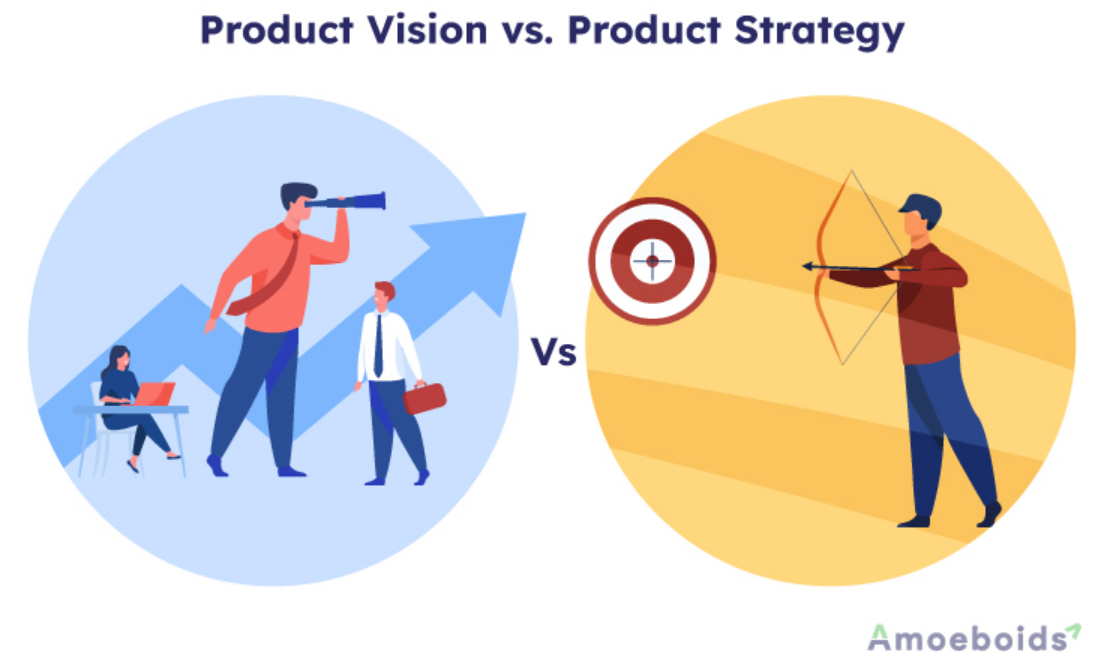When organizations have only one dominant solution, it is easy to assume that the product vision is the same as the company vision. But they are inherently different – a company’s vision is to deliver the product and help its teams succeed. In contrast, a product’s vision defines how the product will deliver value to its users.
What’s a product vision?
A product vision statement is an aspirational goal that describes what the product aims to achieve in the long term. They serve as guides and reminders about the objective of the product to all stakeholders, like product team members (or product development team members), executive decision-makers, and leaders, among others. A product vision statement provides the reason for its existence and what product development should do for its customers. When Google started, the vision for their search engine was to ‘provide access to the world’s information in one click, which they do well.

What’s a product strategy?
A product strategy describes how the organization plans to use the product and achieve the goal that it has set. Key questions such as the customer personas, their likes and dislikes, and how they will use and react to the product – define the goals for the product throughout its life cycle. A product owner or product manager is tasked with developing the product strategy.
Product Vision vs. Product Strategy

At first glance, product vision and strategy may seem similar, but product vision is achieved by the choices defined in the product strategy. Vision, as the name suggests, is a hopeful recount of a future where the product adds value to its users in a specific and unique way. Product strategy, when done right, lists steps and actions that need to be taken by the stakeholders that lead to the realization of the product vision. A product vision is a big, aspirational goal that inspires team members and is the basis for all product strategy choices. While the product vision statement defines the end goal, the product strategy outlines the most efficient way to reach that state.
Why Atlassian Training Is Crucial For Your
Our instructors live and breathe Atlassian and are familiar with all Atlassian products. After mastering the fundamentals, we’ll take your staff well beyond the basics with our innovative Atlassian training methods and top-notch teaching tools.
What comes first: strategy or vision?
Strategy, a set of steps to achieve a predefined goal, needs a target – and product vision provides that target. Visions reflect the dreams of organizational leaders and the core values inherent in those organizations. Statements like “Being the most respected solutions provider in X field” or “Helping people find Y in less than 3 clicks” can be valid vision statements. Vision statements are clear and concise, and they pave the way to developing a product strategy.
Strategies are used to create a product roadmap to achieve the vision. For example, “being the most respected solutions provider in X field” can happen either by monopolizing the market or by having expertise in niche solutions. A strategic planning meeting with stakeholders can reveal multiple inward and outward perspectives on the organization’s future actions. To be the most respected, an organization must first identify how its competitors conduct their business and are “the consultant of choice” by providing value in ways that others can’t.
What is the validation of a product?
Not long ago, CB Insights published a research report that said 50% of the products in the market are unsuccessful because there’s no need for them. The major reasons for this statistic are: not validating the product goal before putting it on the market or not having a well-defined product vision and strategy. Instead of pouring millions on a hunch or skewed data, innovators and organizations can test their ideas with potential users and get feedback on the product’s usage and viability. Not only does this lower the risk of wasting money and time, it also reveals interesting insights that can help enhance the product strategy or pivot it. The goal of the product validation process is to avoid developing until there is relevant and favorable data to build upon. It’s the best way to keep teams focused, increase the chances of a successful product launch, document positives, and negatives, and minimize costs.
The importance of product vision validation
Validation is an important part of the product management process. It helps in understanding where the product excels, where it falls short, and how it can perform better. This knowledge, along with user data, can prove invaluable in creating a winning product. More often than not, people tend to use the word “validation” while explaining the proof that something is correct and not as an act of checking the accuracy of something. People tend to deviate toward finding support for their beliefs, and once the premise is made up, it is easy to find support in numbers.
Creating a roadmap is helpful for the validation of feature requests, feedback, and suggestions. Product managers can also easily identify if the product vision drives the decisions behind feature request adoption. While roadmaps can be created using tools like spreadsheets, using a tailor-made roadmap tool like Roadmap Portal can ensure participation from all the stakeholders. Since the tool integrates natively with Jira, updating or checking the roadmap for progress is as simple as managing a ticket. Access can be controlled too so that an internal roadmap is only seen by the product team members and other relevant stakeholders.
Without product vision validation, product development team members could spend potentially immense amounts of time and energy on a product launch that might not even achieve acceptable levels of usage. Product strategy becomes a mess. Not being right regarding features and product roadmap direction is the worst thing to happen to product managers, as it represents a lost opportunity and wasted effort on all fronts.
Ensuring a smooth validation process
Not every idea can be the next big thing, but searching for those elusive unicorns shouldn’t stop organizations from missing out on regular incremental gains. Giving every idea and feature request a rundown of a few basic processes can ensure the validation is sound.
Listening to end users can lead product management activities to arrive at a strategic product roadmap with a good chance of succeeding. Product managers listen to everyone’s perspective and see if the suggestions fit the product vision.
Distilling the customer feedback and suggestions will clarify the product vision further once the target customer, problem, and methods are finalized. Product managers can take the salient points of important feedback and run them with the team to identify if the effort is worth the payoff if it fits with the product vision and other factors.
Simplifying the way forward can reveal if the product vision document will stand the market test or not. Instead of just identifying the who, what, how, why, and when, crafting a statement where customer success happens because of the product manager’s efforts can get the product team more involved in identifying chinks in the product vision.
Conclusion
Having a memorable product vision and strategies like Google’s or Netflix’s is appealing – but having a lofty vision statement will not compensate for lack of interest. Having the product vision validated beforehand can help product management teams create something that keeps their customers happy right from product launch to eventual upgrade.
Blog post by Amoeboids
Atlassian Managed Services
Free up your team to do their best work and leave the Atlassian maintenance and support to us.






